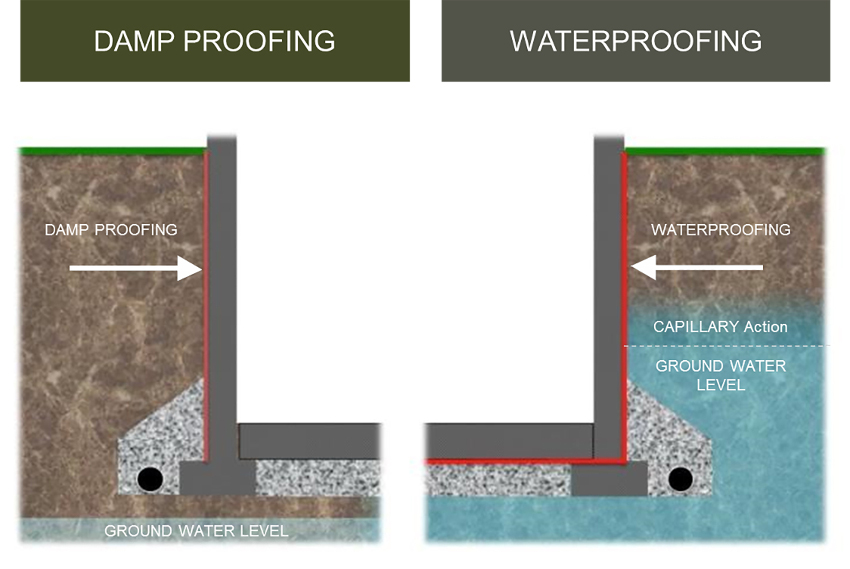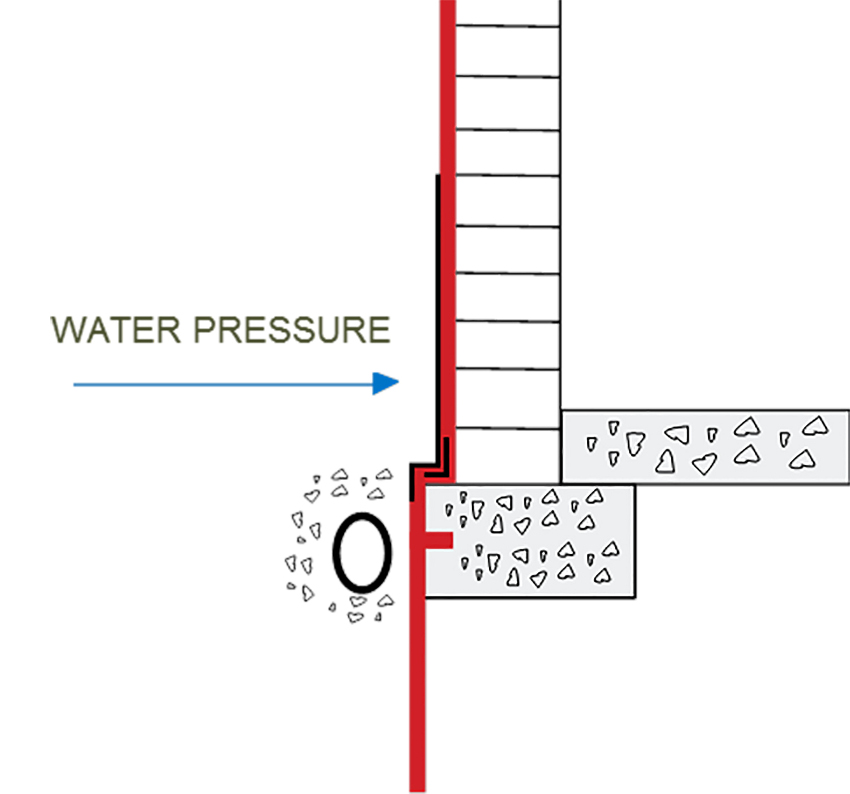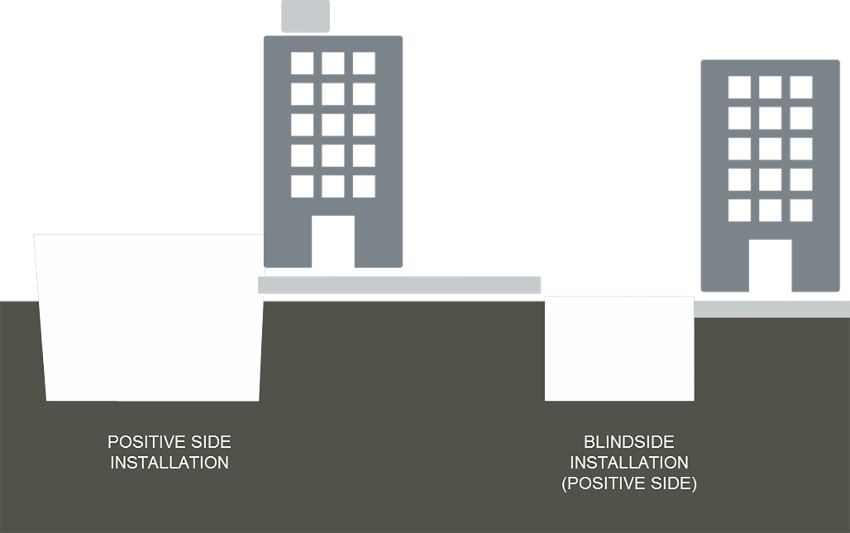Below-Grade Waterproofing Systems and Design
Design & Decisions
You have choices in how you protect your foundations. First and foremost, you need to decide whether you are dampproofing or waterproofing.
In the context of below-grade protection, dampproofing refers to treating a surface to resist the passage of moisture in the absence of hydrostatic conditions (e.g., if your surface is above the water table). Waterproofing, alternatively, refers to treating a surface to prevent the passage of water under hydrostatic conditions.
Note that dampproofing is not a substitute for waterproofing if there’s a realistic chance of hydrostatic conditions forming. For the sake of this article, we will focus primarily on waterproofing materials and methods.

When working at or below the ground water level, waterproofing must take the place of damp proofing.
This visual highlights the difference between dampproofing and waterproofing. It shows us that when you are working within range of the water table (where the ground water level is above the waterproofing or structure level), you need to have a waterproofing material that can handle those hydrostatic conditions that the water table creates.
There are a few ways to go about below-grade waterproofing design. First, there is positive-side waterproofing, which consists of installing a waterproofing membrane/layer between the substrate you are protecting and the source of water. This type of application is commonly referred to as exterior side waterproofing, as the waterproofing materials are applied to the outside of the building.

Waterproofing materials are placed on the outside of the building to block the supply of water in positive-side waterproofing.
Positive-side waterproofing is generally seen as the least problematic option to pursue and tends to be the most successful, since it keeps water out and is actually benefitted by the external water pressure forcing it to work. It also allows the design team to inspect all lap joints and defects with full visibility. The biggest drawback, however, is that once areas have been filled in with earth around the foundation, post-backfill inspection is not possible. If leaks occur due to building movement or faulty installation, repairs can only be made via excavation or interior retrofits.
There are a variety of systems that can be employed for positive-side waterproofing, including:
- Prefabricated membrane systems
- Modified bitumen sheets
- Elastomeric sheets
- Thermoplastic sheets
- Liquid-applied membrane systems
- Cold liquid-applied
- Single component
- Multi component
- Hot liquid-applied
- Mineral-based system
- Bentonite clay
- Crystalline
The prefabricated membrane systems are typically self-adhered, post-applied products (applied after the structure is put in place), but in some cases can be preapplied (or blindside) products—a term we will cover in more depth shortly. Liquid systems are typically post-applied, and mineral-based systems are typically preapplied.
On most projects, below-grade waterproofing is applied after the foundation walls have been poured. On some projects, however, this simply is not possible. That’s where blindside waterproofing comes in.
Blindside waterproofing systems are required when the exterior faces of the foundation walls are inaccessible but a desire to apply positive-side waterproofing is present. The name “blindside” comes from the fact that blindside waterproofing is often attached to an adjacent structure or soil-retention wall rather than the new structure’s wall, and the finished product cannot be seen after installation. These systems are applied prior to the final structure placement, and thus blindside waterproofing is often also referred to as preapplied waterproofing. Although blindside waterproofing is still technically a positive-side application, as it is installed on the outside of the structure, the protection/drainage and waterproofing layers of the assembly are installed before the concrete structure is poured with this type of system.
A common situation dictating blindside waterproofing would be when the proximity of adjacent property lines in “zero lot line” scenarios preclude excavation outside of foundation walls. Picture a densely built-up city block, for instance. Blindside waterproofing is also used in pits—think about elevator pits and tunnels. We also see blindside waterproofing in split- or mud-slab horizontal applications when products are waterproofing the underside of the structural slab. In all of these cases, the common factor is lack of accessibility. When you do not have the capability to access the structure to waterproof it after it is in place, the waterproofing can only be preapplied.
The graphic shown below depicts the difference between positive-side and blindside waterproofing installation. As you can see on the left side of the graphic, a wider excavation zone allowed for positive-side waterproofing installation on the outside of the already-poured foundation. On the right, however, the proximity of the already-built environment around the excavation site meant the blindside waterproofing layer had to be installed first, and the pouring of the foundation will come as a next step.

When outside factors prevent adequate excavation to allow installation of waterproofing layers on the exterior of a foundation, it may be necessary to install the waterproofing layer before the foundation is poured via blindside waterproofing.
As is the case with positive-side waterproofing, there are a variety of materials used in blindside waterproofing, including:
- Bentonite sheets
- Styrene Butadiene Styrene (SBS)-modified bitumen membranes
- Polyvinyl Chloride (PVC) membranes
- High-Density Polyethylene (HDPE) membranes
- Hybrid membranes
Bentonite sheets have been historically popular in blindside applications, but other materials often prove to be better options depending on specifics of the application. All these materials listed above differ in chemical composition and therefore have different physical properties. Some of these materials are more affected by outside factors than others. For example, a modified bitumen system will not be adversely affected by inclement weather or shotcrete applications, whereas bentonite and HDPE systems will. HDPE, for example, can be adversely affected by overexposure to UV rays, and bentonite can be damaged by exposure to even light precipitation.
When choosing materials, keep in mind that some of the key performance properties to analyze for any blindside waterproofing system are adhesion to poured concrete, puncture -resistance and resistance to lateral water migration.
As you might imagine, blindside waterproofing is considerably more complex than the regular way of doing things, but sometimes it’s the easiest—or only—way to get it done. This does not mean blindside waterproofing is explicitly relegated to being chosen as a last resort. In some cases, blindside waterproofing can substantially reduce the area of a jobsite that must be disturbed to waterproof a foundation, and it can reduce the overall developed footprint of the building. Due to its ability to decrease the amount of excavation required and thus minimize site disturbance, choosing blindside waterproofing can help with progress toward environmental accreditations, achieving LEED prerequisites or Sustainable Sites–site development credits. Whether these accreditations are of interest or not, blindside waterproofing may also be of interest if the landholders wish to preserve existing wildlife habitats/plant life or otherwise maintain the grounds.









